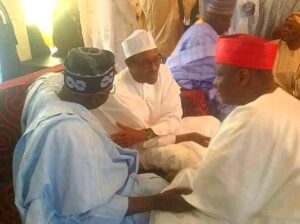
By Ibrahim Kegbegbe
There are moments in history when an ordinary photograph carries within it an extraordinary prophecy. One such image captures three men—Late President Muhammadu Buhari, President Bola Ahmed Tinubu, and Senator Rabiu Musa Kwankwaso—seated in a manner that may yet define Nigeria’s political destiny.
In that photograph, taken during the Buhari administration, President Muhammadu Buhari sat at the center—the symbol of authority and power. To his left sat Bola Ahmed Tinubu, then a kingmaker, strategist, and political philosopher in his own right. Next to Tinubu, on his left, sat Senator Rabiu Musa Kwankwaso—the former Governor of Kano State, a man of discipline, grassroots power, and people-centered politics.
The seating arrangement was more than mere protocol. It was a portrait of succession waiting to unfold.
History has since fulfilled the first part of that visual prophecy: Buhari, the soldier-turned-democrat, handed over to Tinubu, the strategist-turned-president. The second chapter, already being written, is Tinubu’s presidency—2023 to 2031.
But what about the third figure in the frame? Kwankwaso’s calm presence in that photograph, just beside Tinubu, seems to whisper of continuity—a bridge between the north and south, between populism and reform. It’s as though fate itself arranged that seating to say: after Tinubu, comes Kwankwaso.
Political transitions in Nigeria have often been shaped not merely by elections but by alignment, timing, and the deeper rhythm of national consensus. Buhari represented the military discipline and northern conservatism; Tinubu, the architect of modern political coalition-building and southern pragmatism. Kwankwaso embodies what may well be the next phase—grassroots mobilization, northern reawakening, and populist reform.
If Tinubu’s journey from opposition strategist to president teaches us anything, it is that the path to power is a marathon, not a sprint. Kwankwaso, a man who has walked the corridors of power and rebellion alike, seems poised for that long-distance run. His movement, the Kwankwasiyya, is more than a political brand—it’s a social philosophy rooted in discipline, education, and empowerment.
So when one looks again at that photograph, it no longer appears as a mere moment in time. It becomes a prophecy—one that began with Buhari’s reign, continues under Tinubu’s watch, and may culminate with Kwankwaso’s ascendancy after 2031.
READ ALSO:Sanwo-Olu Unveils LASU Library, Ignites Academic Transformation
Perhaps history had already spoken that day. The message was silent, but clear: Power was sitting in sequence.
By Ibrahim Kegbegbe
Journalist and Public Affairs Analyst | Lagos, Nigeria
















